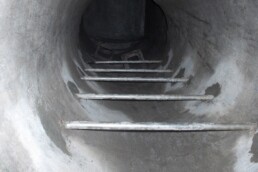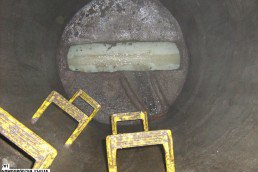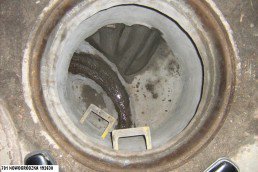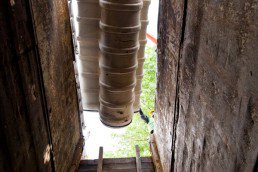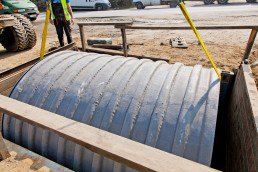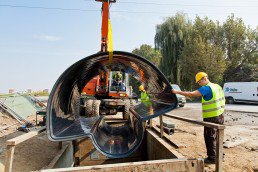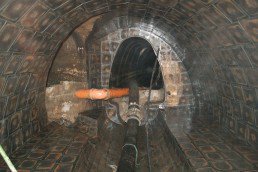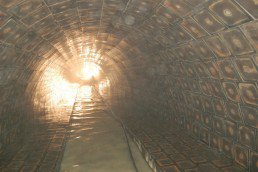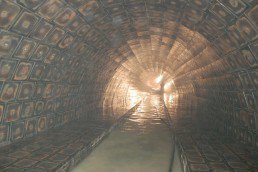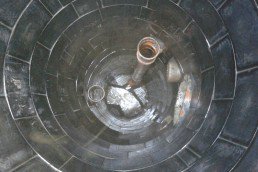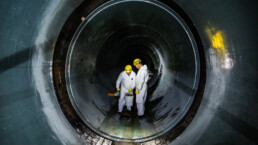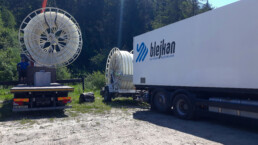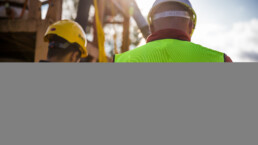REHABILITATION OF MANHOLES AND INSPECTION CHAMBERS USING
REHABILITATION OF MANHOLES AND INSPECTION CHAMBERS USINGMANUALLY APPLIED CHEMICAL RESISTANT COATINGS
Trade name – Construction chemicals
Materials – cement- and polymer-based coating products
Curing – concrete setting
Suppliers – Mc-Bauchemie, MINOVA, P.&T., IPA.
Diameter range – man-accessible sewers, manholes, inspection chambers
Scope of application – SBK
SPRAYED CHEMICAL RESISTANT COATINGS
Trade name – Construction chemicals
Materials – cement- and polymer-based coating products
Curing – concrete setting
Suppliers – Mc-Bauchemie, MINOVA, P.&T., IPA.
Diameter range – man-accessible sewers, manholes, inspection chambers
Scope of application – SBK
Zgodnie z PN-EN 752-5; 13689; 13566-1.
Zgodnie z PN-EN 752-5; 13689; 13566-1.
1. DESCRIPTION OF METHOD
Rehabilitation using chemical resistant mineral liners is used to renovate man-accessible sewers and sewer manholes. They are used in sewers which do not require structural reinforcement. The main purpose of this method is to seal the sewer and remove uneven surface resulting from corrosion of the host sewer. Due to the existing environment in the sewer the material meets many other conditions which qualify it for use in such specific conditions: resistance to sulphates and sulfuric acid, waterproofing properties, vapor permeability, etc.
2. LINER INSTALLATION EQUIPMENT
- sewer cleaning machine (jetting truck) sewer inspection camera hoisting machine (winch) by-pass equipment (pumps, hoses) dropside truck for material transportation crane (or truck with crane) injection grouting pumps sewer fan pneumatic hole saw pneumatic jigsaw test equipment
3. PREPARATION FOR THE INSTALLATION
Technical evaluation of the sewer
Before the rehabilitation the pipe is jet-cleaned with a sewer cleaning machine placed on a truck. After that the pipeline is inspected with a remote-controlled camera. The analysis of the video from the sewer inspection forms the basis to create a detailed computer report on the technical condition of the pipe. On the basis of report data the sewer is classified depending on its technical condition.
SELECTING THE REHABILITATION METHOD
Depending on how the sewer is damaged or destroyed and its classification to a specific group, depending on its technical condition an appropriate rehabilitation method is selected. After the evaluation of the sewer’s technical condition one should analyze geodetic data, groundwater level with respect to the base of the sewer, road traffic exposure, and other parameters that have influence on the selection of parameters of the liner that is to be used.
Storage and transportation to the construction site
The liner is delivered in bags or bulk to a stacking yard (warehouse) and from there it is delivered to the construction site in appropriate batches.
4. LINER INSTALLATION
The order of works of placing the appropriate layer of chemical resistant mineral surface is as follows:
Sewer cleaning from any existing small and large debris using a jetting truck (10-20 MPa) and manual cleaning of rubble and stones.
High-velocity water jetting (70-100 MPa) of the walls and ceiling of the sewer to dislodge any corroded loose sewer structure fragments and remove fats and other fixed foreign matter.
Preparing the walls and ceiling for the application of the mineral layer – removal of dripstone, leaks and unevenness using additional materials (quick-curing mortars, tack coats and injection grouts).
Spraying a mineral layer onto the wet surface of the sewer using a screw pump. In the case of brick sewers two layers are sprayed. The first layer is to fill the joints between the bricks and identify any missed minor leaks which must be removed before the application of the second layer. The optimal layer thickness is 10 mm, and if multiple layers are applied the thickness must not exceed 25 mm.
Drying the sewer by putting by-passes and connections. A by-pass can be made inside the sewer and then the flow is driven entirely by gravity, or outside using sewage pumps of a capacity of up to 1,200 m3/h.
Cleaning sewer floor using a jetting truck.
Hydrojetting or wet sandblasting the sewer floor.
Preparing sewer floor for the application of a mineral layer using additional materials.
Spraying a mineral layer or applying it by hand (egg-shaped sewers).
By-pass removal and minor corrections after removing external by-pass.
The sewer is usable after ca. 8 hours from the final application of the layer.
5. INSPECTION
CCTV inspection
Once the installation is finished and connections are opened a CCTV acceptance inspection is made and recorded on a VHS cassette or CD. At the same time an inspection report is prepared.
Tests
In accordance with PN-EN 13566-1.
6. DEFECT REMEDIATION
Any defects are made good using the main material of the applied chemical resistant mineral layer or using specialized materials.
Selected projects
Renovating one of Warsaw’s most important collector
We are renovating one of Warsaw's most important…
24 January 2020
Trenchless renovation of the sewage network
We are slowly approaching the end of the trenchless…
24 January 2020
Trenchless renovation of the sewage network in 20 streets in 9 districts of Warsaw
We are implementing an investment involving the trenchless…
24 January 2020
